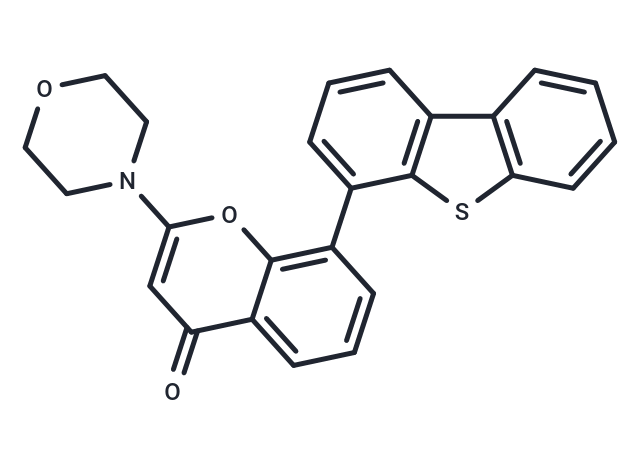Shopping Cart
- Remove All
 Your shopping cart is currently empty
Your shopping cart is currently empty

NU7441 (KU-57788 (NU7441)) is a highly effective and specific DNA-PK inhibitor (IC50: 14 nM).

| Pack Size | Price | Availability | Quantity |
|---|---|---|---|
| 2 mg | $34 | In Stock | |
| 5 mg | $54 | In Stock | |
| 10 mg | $90 | In Stock | |
| 25 mg | $175 | In Stock | |
| 50 mg | $297 | In Stock | |
| 100 mg | $413 | In Stock | |
| 500 mg | $979 | In Stock |
| Description | NU7441 (KU-57788 (NU7441)) is a highly effective and specific DNA-PK inhibitor (IC50: 14 nM). |
| Targets&IC50 | DNA-PK:13 nM (cell free) |
| In vitro | 0.3 μM of KU-57788 (NU7441), nontoxic to both normal and tumor cells, caused a significant radio-sensitization in tumor cells exposed to X-rays and carbon ions. This concentration did not seem to cause inhibition of DNA DSB repair but induced a significant G2/M arrest [1]. The addition of NU7441 to cells following introduction of the Cas9/sgGFP editing system and the ΔGFP repair template caused a decrease of approximately 40 % in NHEJ events which was accompanied by an approximately two-fold stimulation in HDR. This effect was dose-dependent and reached a maximum at approximately 2.0 μM for NU7441 [2]. NU7441 reduced the CCK-8 counts in the HepG2 culture, further enhanced 60Cox03B3; radiation injury to HepG2 cells, which was manifested by decreasing the DNA-PKcs (S2056) protein expression, increasing x03B3 [3]. Even though RPA p34 is still localized into foci following UV-irradiation and inhibitor treatment, treatment of cells with NU7441 eliminates staining for hyperphosphorylated RPA p34 [4]. |
| In vivo | Tumors in control mice reached four times their starting volume (RTV4) at a median time of 5.6 days. Treatment with etoposide phosphate alone caused a tumor growth delay of 2.7 days, which was extended to 5.4 days by coadministration of NU7441 [5]. |
| Cell Research | Cells were irradiated with 290 MeV/n carbon ions (LET: 50 keV/μm) at the Heavy Ion Medical Accelerator in Chiba. The dose rate for carbon ions was 1 Gy/min. X‐ray irradiation was performed using a TITAN‐320 (200 kV, 20 mA) at a dose rate of 1 Gy/min. NU7441 was dissolved in DMSO and stored at ?20°C in a freezer. Cells were pretreated with NU7441 1 h before irradiation, and the drug was kept throughout the experiment [1]. |
| Animal Research | All in vivo experiments were reviewed and approved by the relevant institutional animal welfare committees and done according to national law. We determined the plasma pharmacokinetics after administering NU7441 i.v. at 5 mg/kg in 10% DMSO/10% cyclodextrin in saline or i.p. or orally at 10 mg/kg (dissolved at 1 mg/mL in 40% PEG400/saline) to female BALB/c mice. These were the maximum administrable doses by the route used due to the limit of solubility of NU7441. Mice were killed at intervals up to 360 minutes after NU7441 administration; blood was taken and immediately centrifuged, and the plasma fraction was removed and stored at ?20°C [5]. |
| Alias | NU7441 |
| Molecular Weight | 413.49 |
| Formula | C25H19NO3S |
| Cas No. | 503468-95-9 |
| Smiles | O=c1cc(oc2c(cccc12)-c1cccc2c3ccccc3sc12)N1CCOCC1 |
| Relative Density. | 1.376g/cm3 |
| Storage | Powder: -20°C for 3 years | In solvent: -80°C for 1 year | Shipping with blue ice. | ||||||||||
| Solubility Information | DMSO: 1 mg/mL (2.42 mM), Sonication is recommended. | ||||||||||
Solution Preparation Table | |||||||||||
DMSO
| |||||||||||

Copyright © 2015-2025 TargetMol Chemicals Inc. All Rights Reserved.